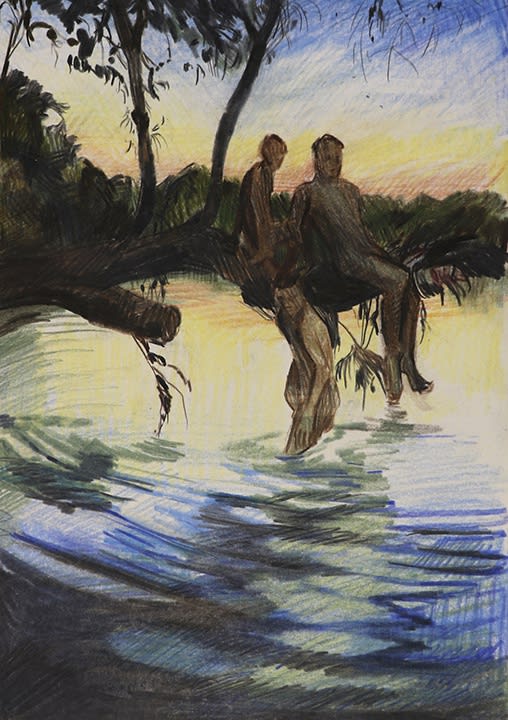-
Jake Grewal & Jordan Cook & Johann Rohl
IN CONVERSATION -
Jake Grewal: I met Jordan Cook and Johann Rohl in 2018 during the postgraduate program at The Royal Drawing School. Our friendship has evolved over time much like our practices and although I feel we’ve known each other longer, it’s recently we’ve started to confide in one another. Sharing an intensely unique experience like The Drawing Year creates invisible ties between us and we feel comfortable talking about drawing, identity, trauma and inspirations. Here are some topics we talked about as the sun set on board a boat in Vauxhall.
-

-

Jordan Cook - $5 Rose
-

Johann Rohl - Gemini
-
 Jake Grewal - Forgetting to Remember
Jake Grewal - Forgetting to Remember -
JG: I’ve often felt a sense of isolation in regards to finding a tribe or like-minded people. I’m not sure whether it is something to do with growing up in London, a city so big as there is a sense of anonymity, the idea ones notion of difference is hand in hand with the queer experience or that is inherently human to feel other. I find it interesting that in spaces,for me, like gay bars, often make me feel a sense of unease or disconnect.
How important are queer spaces to you and how did do you operate within such a vast city like London?
-

Jordan Cook - Ball Games
-

Johann Rohl - Untitled III
-
JG: When thinking of the commonalities between the works, the inclusion of and retreat into a physical or abstract space seemed poignant and relevant. I frequently look to natural spaces in my work often observationally drawing from the landscapes around where I live, searching for solace. I return to certain places more than others and this practice often feels like a kind of mediation or pilgrimage. The inclusion of nature in the work is often used metaphorically or allegorically alluding to semi-autobiographic experiences. I try to look at figurative elements of the work abstractly allowing room for speculation behind inclusion of visual clues. When working with the landscape I try to treat it as if it were a portrait, I see no difference. One can say with a landscape what one can say with bodies. Both are living and tell a story.
What spaces do you include in your work and how does that talk to your internal space?
-
JC: Most of the spaces in my work are based on places I've grown up in. I'm quite overly-sentimental about a lot of things, and I think that the spaces that I create for myself in my drawings offer me somewhere to offload all of that onto. They're very banal places, but they carry a lot of baggage which I quite enjoy unpicking. There's something about the process of piecing together fragments of themes that emerge that feels really cathartic to me. It becomes less about the actual drawing and more about the meditative space, and if people enjoy looking at the drawings after too then that's pretty cool.
JR: I see the spaces in my drawings as landscapes of the inner world and so they don’t tend to make much sense to me at the time of conception. I tend to think about the spaces in my drawings the least in the process but they seem to be important to me in trying to convey a feeling or an idea. I like having the space reveal itself to me when working on a piece and seeing how it encapsulates both the feeling channelled and something completely new.
-

Jake Grewal - Self Portrait
-
JC: I used to have a particular playlist I'd go to when working in the studio, but recently I've become more interested in switching between different genres or trying the radio and seeing how it impacts the way that I'm working. It's about the thereness of it more than anything, a rhythm in the background that reminds of the outside world. Or maybe my music taste is just really stale now, I'm not sure.
JR: Music is a big part of my life and work and I very rarely make drawings without it as it’s the easiest way for me to tap into a mood or atmosphere. I get really taken in by catchy hooks and riffs that get lodged in my brain so I have to draw sometimes in order to get them loose. I grew up listening to an eclectic mix of music but what really got me was pop music, especially the songs produced by Max Martin who worked with Britney spears and The Backstreet Boys. He contributed to a lot of the soundtracks to my life growing up so that love for simple, catchy melody has stuck with me and I think it's shaped a lot of what my interests are in art and the way that I make images.
-

Johann Rohl - Untitled I
-
JC: I try not to complicate going into the studio too much, there'd be too much pressure otherwise. Though I'm always thinking about artists. Recently it's been a wrestle between Leon Golub, David Park, Sam Doyle, Alice Neel, and Anselm Kiefer. Egon Schiele is always there too. Oh and Bruegel is a new one for me.
JR: I've made a lot of work to Kate Bush - The Hounds of Love and Aerial so I've carried a lot of the different energies from those albums into my earlier drawings. Again, it's mostly songs or albums that i like to let consume me in order to work because it's the quickest route to feeling and I like how much that can affect the creative decisions I make on the plane.
-

-

-





















